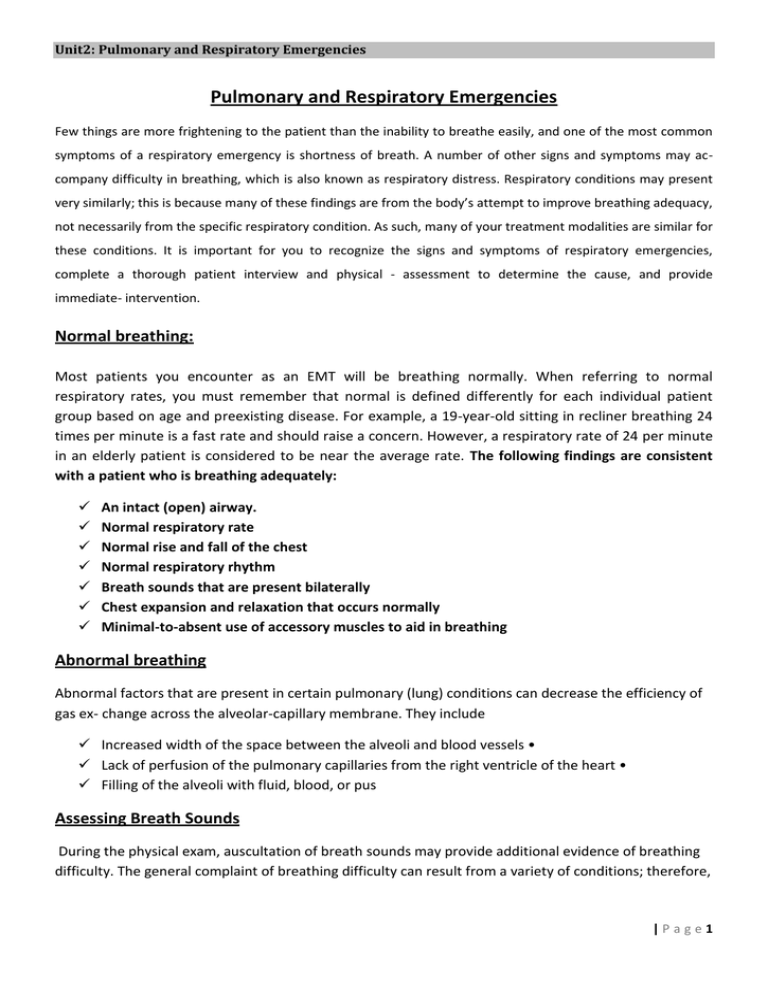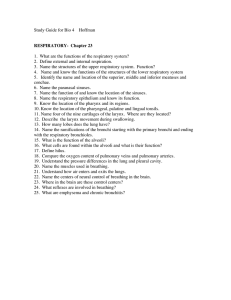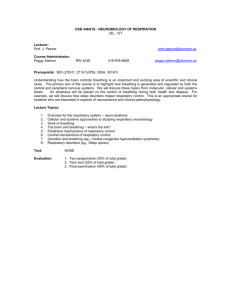Pulmonary and Respiratory Emergencies
advertisement

Unit2: Pulmonary and Respiratory Emergencies Pulmonary and Respiratory Emergencies Few things are more frightening to the patient than the inability to breathe easily, and one of the most common symptoms of a respiratory emergency is shortness of breath. A number of other signs and symptoms may accompany difficulty in breathing, which is also known as respiratory distress. Respiratory conditions may present very similarly; this is because many of these findings are from the body’s attempt to improve breathing adequacy, not necessarily from the specific respiratory condition. As such, many of your treatment modalities are similar for these conditions. It is important for you to recognize the signs and symptoms of respiratory emergencies, complete a thorough patient interview and physical - assessment to determine the cause, and provide immediate- intervention. Normal breathing: Most patients you encounter as an EMT will be breathing normally. When referring to normal respiratory rates, you must remember that normal is defined differently for each individual patient group based on age and preexisting disease. For example, a 19-year-old sitting in recliner breathing 24 times per minute is a fast rate and should raise a concern. However, a respiratory rate of 24 per minute in an elderly patient is considered to be near the average rate. The following findings are consistent with a patient who is breathing adequately: An intact (open) airway. Normal respiratory rate Normal rise and fall of the chest Normal respiratory rhythm Breath sounds that are present bilaterally Chest expansion and relaxation that occurs normally Minimal-to-absent use of accessory muscles to aid in breathing Abnormal breathing Abnormal factors that are present in certain pulmonary (lung) conditions can decrease the efficiency of gas ex- change across the alveolar-capillary membrane. They include Increased width of the space between the alveoli and blood vessels • Lack of perfusion of the pulmonary capillaries from the right ventricle of the heart • Filling of the alveoli with fluid, blood, or pus Assessing Breath Sounds During the physical exam, auscultation of breath sounds may provide additional evidence of breathing difficulty. The general complaint of breathing difficulty can result from a variety of conditions; therefore, |Page1 Unit2: Pulmonary and Respiratory Emergencies being able to describe the type of breath sounds may be helpful to medical direction when you ask for a medication order. Three basic types of abnormal breath sounds that you might hear upon auscultation of the thorax may be early indicators of impending respiratory distress. Wheezing is a high-pitched, musical, whistling sound that is best heard initially on exhalation but may also be heard during inhalation in more severe cases. It is an indication of swelling and constriction of the inner lining of the bronchioles. Wheezing that is diffuse (heard over all the lung fields) is a primary indication for the administration of a beta2 agonist medication by metered-dose inhaler or by small-volume nebulizer. Wheezing is usually heard in asthma, emphysema, and chronic bronchitis. It may also be heard in pneumonia, congestive heart failure, and other conditions when they cause bronchoconstriction. Rhonchi are snoring or rattling noises heard upon auscultation. They indicate obstruction of the larger conducting airways of the respiratory tract by thick secretions of mucus. Rhonchi are often heard in chronic bronchitis, emphysema, aspiration, and pneumonia. One characteristic of rhonchi is that the quality of sound changes if the person coughs or sometimes even when the person changes position. Crackles, also known as rales, are bubbly or crack- ling sounds heard during inhalation. These sounds are associated with fluid that has surrounded or filled the alveoli or very small bronchioles. Crackles may indicate pulmonary edema or pneumonia. This type of breath sound typically does not change with coughing or movement. Respiratory distress The majority of patients you will encounter as an EMT will display an adequate respiratory effort (normal breathing). However, you may encounter a patient with inadequate breathing, or find that a patient who was initially breathing adequately has deteriorated to a point where breathing is inadequate and insufficient to sustain life. Respiratory emergencies may range from “shortness of breath,” or dyspnea, to complete respiratory arrest, or apnea, A variety of diseases that may cause respiratory distress: Obstructive pulmonary diseases Emphysema Chronic bronchitis Asthma Pneumonia Pulmonary embolism Pulmonary edema |Page2 Unit2: Pulmonary and Respiratory Emergencies Obstructive pulmonary diseases An obstructive lung disease causes an obstruction of airflow through the respiratory tract, leading to a reduction in gas exchange. The most severe consequence of reduced airflow is hypoxia. Emphysema Emphysema is a permanent disease process distal to the terminal bronchiole that is characterized by destruction of the alveolar walls and distention of the alveolar sacs and a gradual destruction of the pulmonary capillary beds with a severe reduction in the alveolar/capillary area for gas exchange to occur. It is more common in men than in women. The primary cause of COPD is cigarette smoking. Persons who are exposed continuously to environmental toxins are also predisposed to developing emphysema. Assessment. Many of the signs and symptoms of emphysema are similar to those listed earlier for respiratory distress and may include the following: • Anxious, alert, and oriented • Dyspnea • Uses accessory muscles Prolonged exhalation • Diminished breath sounds • Wheezing and rhonchi on auscultation Tachycardia (increased heart rate) • Diaphoresis (sweating; moist skin) Chronic Bronchitis Chronic bronchitis is a disease process that affects primarily the bronchi and bronchioles. Like emphysema, chronic bronchitis is associated with cigarette smoking. By definition, chronic bronchitis is characterized by a productive cough that persists for at least three consecutive months a year for at least two consecutive years. . Assessment. The following are signs and symptoms of chronic bronchitis Cough (hallmark sign) is prominent; vigorous coughing produces sputum Typically overweight, with prominent peripheral edema and chronic jugular vein distention Minimal difficulty in breathing and anxiety, unless in respiratory failure SpO2 reading of <94%, indicating chronic hypoxemia Wheezes and, possibly, crackles at the bases of the lungs Emergency Medical Care for Emphysema and Chronic Bronchitis. Ensuring an open airway and adequate breathing , position of comfort, and administration of supplemental oxygen if necessary are key elements in managing these patients. The patient may also have a prescribed metered-dose inhaler or small-volume nebulizer. Oxygen administration should take precedence over a concern about whether the hypoxic drive is going to be lost and cause the patient to stop breathing. (If this should happen, you would initiate positive pressure ventilation with supplemental oxygen, as for any patient with inadequate ventilation.) Asthma is a common respiratory condition that you may be called to the scene to manage. The most common complaint of the asthma patient is severe shortness of breath. |Page3 Unit2: Pulmonary and Respiratory Emergencies Many asthma patients are aware of their condition and have medication to manage the disease and its signs and symptoms. You may be called to the scene for a patient who is suffering an early-onset asthma attack or one in which the patient’s medication is not reversing the attack. Assessment. The following are signs and symptoms of asthma: Dyspnea (shortness of breath); Cough; often begins early and may be the only sign or symptom of an asthma attack, especially in elderly; Wheezing on auscultation (typically expiratory); may become diminished or absent with a severe reduction in airflow in the bronchioles. Tachypnea Tachycardia (A heart rate greater than 120 bpm with tachypnea often indicates a severe asthma attack.) Use of accessory muscles Diaphoresis secondary due to an increase in the work of breathing, Anxiety and apprehension SpO2 <94% Indicators of a critically ill asthma attack patient are as follows: • Upright position • Signs and symptoms of severe respiratory distress • Tachypnea (>20/minute and often >40/minute) • Tachycardia (usually >120 bpm) • Diaphoresis • Accessory muscle use • Speech is single words or syllables • Wheezing may be absent due to severe bronchiole obstruction and minimal airflow • Decreasing consciousness and bradypnea • Extreme fatigue or exhaustion; the patient is too tired to breathe • SpO2 <90% with supplemental oxygen Emergency Medical Care for Asthma During the primary assessment, you would have Established and maintained an airway, Applied oxygen or begun positive pressure ventilation with supplemental oxygen, and assessed the adequacy of circulation to maintain an SpO2 of 94% or greater. If signs of severe hypoxia are not present, this usually can be achieved by using a nasal cannula. In the pregnant patient and those with preexisting cardiac disease, maintain a SpO2 of 95%. During the physical exam, it is necessary to calm the patient to reduce his workload of breathing and oxygen consumption. If the patient has a prescribed metered-dose inhaler or small-volume nebulizer, ad- ministration of the beta agonist medication should provide some relief of the breathing difficulty. CPAP may be beneficial in the acute asthma patient in respiratory distress |Page4 Unit2: Pulmonary and Respiratory Emergencies Other Conditions that Cause respiratory distress Pneumonia Is a common cause of death in the United States, especially in the elderly. Patients infected with the human immunodeficiency virus (HIV) and others who are on immunosuppressive drugs, such as transplant patients, are also very prone to pneumonia. Additional risk factors include cigarette smoking, alcoholism, and exposure to cold temperatures. Assessment. The signs and symptoms of pneumonia vary with the cause and the patient’s age. Malaise and decreased appetite • Fever (may not occur in the elderly) • Cough—may be productive or nonproductive • Dyspnea (less frequent in the elderly) • Tachypnea and tachycardia • Chest pain—sharp and localized and usually made worse when breathing deeply or coughing Decreased chest wall movement and shallow respirations • Splinting of thorax by patient with his arm • Crackles, localized wheezing, and rhonchi heard on auscultation Altered mental status, especially in the elderly • Diaphoresis • Cyanosis • SpO2 <94% Emergency Medical Care. Ensure the patient has an adequate Airway, ventilation, and oxygenation. Administer supple- mental oxygen via a nasal cannula at 2 to 4 lpm to maintain a SpO2 of 94%. In severe cases of hypoxia, a non rebreathe may be used. Consult medical direction and follow your local protocol for the use of the metered-dose inhaler or small-volume nebulizer and the administration of CPAP. Pulmonary Embolism In pulmonary embolism, an obstruction of blood flow in the pulmonary arteries leads to hypoxia. Patients at risk for suffering a pulmonary embolism are those who experience long periods of immobility (such as bedridden individuals, those who travel for a long period confined in one position, those with splints to extremities) as well as those with heart disease, recent surgery, long-bone fractures, venous pooling associated with pregnancy, cancer, deep vein thrombosis (development of clots in the veins, most commonly in the legs), estrogen therapy, clotting disorders, history of previous pulmonary embolism, and those who smoke. Assessment Signs and symptoms of pulmonary embolism depend on the size of the obstruction. |Page5 Unit2: Pulmonary and Respiratory Emergencies Sudden onset of unexplained dyspnea • Signs of difficulty in breathing or respiratory distress; rapid breathing • Sudden onset of sharp, stabbing chest pain • Cough (may cough up blood) • Tachypnea • Tachycardia • Syncope (fainting) • Cool, moist skin • Restlessness, anxiety, or sense of doom • Decrease in blood pressure or hypotension (late sign) • Cyanosis (may be severe) (late sign) • Distended neck veins (late sign) • Fever • SpO2 <94% • Signs of complete circulatory collapse. Emergency Medical Care During the primary assessment, you would have opened the airway and would have initiated positive pressure ventilation with supplemental oxygen or applied supplemental oxygen to maintain a SpO2 reading of more than 94%. It is important to begin oxygen administration early on and to continuously monitor the patient for signs of respiratory arrest. Immediately transport the patient. Epiglottitis Epiglottitis, an inflammation affecting the upper airway, can be an acute, severe, life-threatening condition if left untreated. Assessment. The following are signs and symptoms of epiglottitis: Upper respiratory tract infection, usually for 1 to 2 days prior to onset Dyspnea, usually with a more rapid onset High fever (although it can occur with only mild fevers) Sore throat and pharyngeal pain Inability to swallow with drooling (late sign of impending failure) Anxiety and apprehension Tripod position, usually with jaw jutted forward (late sign of impending failure) Fatigue High-pitched inspiratory stridor ,Cyanosis Trouble or pain during speaking SpO2 <94% Emergency Medical Care. Treatment of epiglottis- is focused on ensuring oxygenation and preventing airway obstruction. If the patient’s breathing is still adequate, the first step is administration of highconcentration oxygen at 15 lpm to maximize oxygenation of the alveoli receiving airflow |Page6 Unit2: Pulmonary and Respiratory Emergencies The younger patient, maintaining a calm and quiet environment will help the patient to remain calm, and lessen the burden of respiratory distress. Keep the patient in a position that is comfortable to him, and expedite transport with ALS intercept if possible. There is absolutely no need to force an inspection of the airway so long as the patient is adequately ex- changing air, and it should not be attempted. Any additional irritation to the inflamed epiglottis may result in additional swelling that totally occludes the airway If the patient continues to deteriorate and requires assisted ventilations with a bag-valvemask device, squeeze the bag slowly. This will help direct the air past the obstruction and into the lungs rather than into the esophagus to inflate the stomach a metered-dose inhaler and a Small-volume nebulizer A medication commonly prescribed for the patient with a chronic history of breathing problems is a beta2-specific bronchodilator that comes in a metered-dose inhaler (MDI) or that can, alternatively, be administered from a small-volume nebulizer (SVN). The medication is dispensed as an aerosol, or mist, that the patient inhales. If the patient has an MDI, the medication is already contained in the device, ready to be dispensed in aerosol form. If the patient, instead, uses an SVN, the liquid medication must be placed into the device where compressed air or oxygen converts it into an aerosol mist Most people who use prescribed bronchodilator medications will have an MDI, rather than an SVN, because the MDI is more convenient for the patient to use. SVNs are more commonly used in hospital settings, but some patients with chronic conditions will have an SVN for use at home. |Page7



